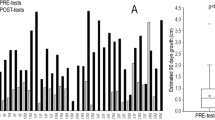Abstract
Dissociation between GH bioactivity (bio-GH) and GH immunoactivity (immuno-GH) is due to the heterogeneity of the molecule: the measurements do not always provide reliable information on the bio-GH. We studied the ratio of bio-GH and immuno-GH during pharmacological secretion tests in 211 sera to study the concentration-response curve of the assay (C1 ), 16 samples of normally growing subjects with idiopathic short stature (C2), 13 samples from patients with GH deficiency (GHD1) and 6 samples of 3 patients with GHD and normal provocative tests (GHD2). GH bioactivity was determined by the Nb2 cell proliferation assay (bio-GH) and immuno-GH by a time-resolved immunofluorometric assay (IFMA) (immuno-GH). A non-linear negative relationship between the serum bio-GH/immuno-GH ratio and serum immuno-GH was observed in C1. In log-log plotting representation, two cut-off lines were drawn: a vertical cut-off line separating above-below cut-off serum peak immuno-GH values in provocative tests, and a diagonal cut-off line separating normal-abnormal serum bio-GH/immuno-GH ratio; four areas were defined. GHD1 had normal ratios, but below cut-off peak immuno-GH responses. P2 and P3 of Group GHD2 had abnormal ratios in samples with low serum immuno-GH but only P2 had autosomal dominant mutation. P1 had the same autosomal dominant isolated GHD as P2 but a low normal ratio. Our data underline the importance of relatively low serum GH concentrations in mediating GH biological actions. An abnormal serum bio-GH/immuno-GH ratio might explain certain cases of GHD and might be useful in detecting abnormal circulating isoforms of GH in patients with growth failure.
Similar content being viewed by others
References
Growth hormone research society. Consensus guidelines for the diagnosis and treatment of growth hormone (GH) deficiency in childhood and adolescence: summary statement of the GH Research Society. J Clin Endocrinol Metab 2000, 85: 3990–3.
Chaler E, Belgorosky A, Maceiras M, Mendioroz M, Rivarola MA. Between-assay differences in serum GH measurements: importance in the diagnosis of GH deficiency in childhood. Clin Chem 2001, 47: 1735–8.
Bozzola M, Zecca M, Locatelli F, et al. Evaluation of growth hormone bioactivity using the Nb2 cell bio-assay in children with growth disorders. J Endocrinol Invest 1998, 21: 765–70.
Baumann G. Growth hormone heterogeneity: genes, isohormones, variants, and binding proteins. Endocr Rev 1991, 12: 424–49.
Radetti G, Bozzola M, Pagani S, Street ME, Ghizzoni L. Growth hormone immunoactivity does not reflect bioactivity. Pediatr Res 2000, 48: 619–22.
Strasburger CJ, Dattani MT. New growth hormone assays: potential benefits. Acta Paediatr (Suppl) 1997, 423: 5–11.
Tanaka T, Shiu RPC, Gout PW, Beer CT, Noble RL, Friesen HG. A new sensitive and specific bio-assay for lactogenic hormones: measurement of prolactin and growth hormone in human serum. J Clin Endocrinol Metab 1980, 51: 1058–63.
Takahashi Y, Shirono S, Arisaka O, et al. Biologically inactive growth hormone caused by an aminoacid substitution. J Clin Invest 1997, 100: 1159–65.
Binder G, Benz MR, Elmlinger M, Pflaum C-D, Strasburger CJ, Ranke MB. Reduced human growth hormone (hGH) bioactivity without a defect of the GH-1 gene in three patients with rhGH responsive growth failure. Clin Endocrinol (Oxf) 1999, 5: 89–95.
Rivarola MA, Mendilaharzu H, Warman MD, et al. Endocrine disorders in 66 suprasellar and pineal tumors of prepubertal and pubertal patients. Horm Res 1992, 37: 1 -6.
Marino R, Chaler E, Warman M, et al. The serum growth hormone (GH) response to provocative tests is dependent on type of assay in autosomal dominant isolated GH deficiency because of an ARG183HIS (R183H) GH-1 gene mutation. Clin Chem 2003, 49: 1002–5.
Albertsson-Wikland K, Jansson C, Rosberg S, Novamo A. Time-resolved immunofluorometric assay of human growth hormone. Clin Chem 1993, 39: 1620–5.
Radetti G, Bozzola M, Paganini C, et al. Growth hormone bioactivity and levels of growth hormone, growth hormone-binding protein, insulin-like growth factor I, and insulin-like growth factor-binding proteins in premature and full-term newborns during the first month of life. Arch Pediatr Adolesc Med 1997, 151: 170–5.
Chen EY, Liao YC, Amith DH, et al. The human growth hormone locus: nucleotide swequence, biology and evolution. Genomics 1989, 4: 479–97.
Sanger F, Nicklen S, Coulson AR. DNA sequencing with chain-terminating inhibitors. Biotechnology 1992, 24: 104–8.
Wada M, Uchida H, Ikeda M, et al. The 20-kilodalton (kDa) human growth hormone (hGH) differs from the 22-kDa hGH in the complex formation with cell surface hGH receptor and hGH-binding protein circulating in human plasma. Mol Endocrinol 1998, 12: 146–56.
Gent J, van Kerkhof P, Roza M, Bu G, Strous GJ. Ligand-in-dependent growth hormone receptor dimerization occurs in the endoplasmic reticulum and is required for ubiquitin system-dependent endocytosis. Proc Natl Acad Sci U S A 2002, 99: 9858–63.
Fuh G, Cunningham BC, Fukunaga R, Nagata S, Goeddel DV, Wells JA. Rational design of potent antagonists to the human growth hormone receptor. Science 1992, 256: 1677–80.
Martha PM Jr, Goorman KM, Blizzard RM, Rogol AD, Veldhuis JD. Endogenous growth hormone secretion and clearance rates in normal boys as determined by deconvolution analysis: relationship to age, pubertal status, and body mass. J Clin Endocrinol Metab 1992, 74: 336–44.
Giustina A, Veldhuis JD. Pathophysiology of the neuroregulation of growth hormone secretion in experimental animals and the human. Endocr Rev 1998, 19: 717–97.
Kowarsky AA, Schneider J, Ben-Galim E, Weldon VV, Daughaday WH. Growth failure with normal serum RIA-GH and low somatomedin activity: somatomedin restoration and growth acceleration after exogenous GH. J Clin Endocrinol Metab 1978, 47: 461–4.
Takahashi Y, Kaji H, Okimura Y, Goji K, Abe H, Chihara K. Brief report: short stature caused by a mutant growth hormone. N Engl J Med 1996, 334: 432–6.
Author information
Authors and Affiliations
Corresponding author
Rights and permissions
About this article
Cite this article
Chaler, E.A., Travaglino, P., Pagani, S. et al. Dose dependency of the serum bio/immuno GH ratio in children during pharmacological secretion tests. J Endocrinol Invest 29, 109–114 (2006). https://doi.org/10.1007/BF03344082
Accepted:
Published:
Issue Date:
DOI: https://doi.org/10.1007/BF03344082



